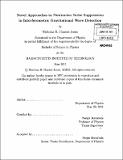Novel approaches to Newtonian noise suppression in interferometric gravitational wave detection
Author(s)
Hunter-Jones, Nicholas R
DownloadFull printable version (4.861Mb)
Other Contributors
Massachusetts Institute of Technology. Dept. of Physics.
Advisor
Nergis Mavalvala.
Terms of use
Metadata
Show full item recordAbstract
The Laser Interferometer Gravitational-wave Observatory (LIGO) attempts to detect ripples in the curvature of spacetime using two large scale interferometers. These detectors are several kilometer long Michelson interferometers with Fabry-Perot cavities between two silica test masses in each arm. Given Earth's proximity to various astrophysical phenomena LIGO must be sensitive to relative displacements of 1018 m and thus requires multiple levels of noise reduction to ensure the isolation of the interferometer components from numerous sources of noise. A substantial contributor to the Advanced LIGO noise in the 1-10 Hz range is Newtonian (or gravity gradient) noise which arises from local fluctuations in the Earth's gravitational field. Density fluctuations from seismic activity as well as acoustic and turbulent phenomenon in the Earth's atmosphere both contribute to slight variations in the local value of g. Given the direct coupling of gravitational fields to mass the LIGO test masses cannot be shielded from this noise. In an attempt to characterize and reduce Newtonian noise in interferometric gravitational wave detectors we investigate seismic and atmospheric contributions to the noise and consider the effect of submerging a gravitational wave detector.
Description
Thesis (S.B.)--Massachusetts Institute of Technology, Dept. of Physics, 2011. Cataloged from PDF version of thesis. Includes bibliographical references (p. 63-65).
Date issued
2011Department
Massachusetts Institute of Technology. Department of PhysicsPublisher
Massachusetts Institute of Technology
Keywords
Physics.